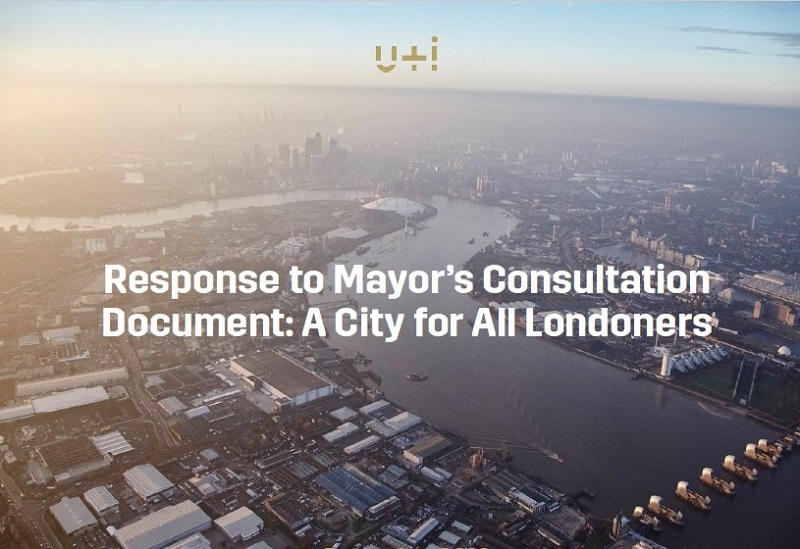Response to Mayors consultation document
Contents |
[edit] Introduction
In December 2016, U+I welcomed the consultation on A City for All Londoners and the Mayor’s willingness to shake things up and to refine London’s planning system as a means of delivering the homes, jobs and places that the city needs.
U+I is active across London and at the forefront of delivering high quality new environments and creative responses that meet both existing and emerging needs. They regularly deliver public private partnership projects, with London Boroughs, Transport for London (TfL) and even the London Fire Brigade.
U+I have pulled together their feedback on the Mayor’s plans.
Part of the response includes a review of planning policy and they have also put forward six key recommendations which they believe would address some of the key issues affecting the Mayor’s direction of travel.
[edit] 1. Enable mixed-use
Local authorities should be directed to encourage productivity on strategic industrial locations (SIL)-designated assets of employment with mixed use developments where exemplary solutions like The Old Vinyl Factory in Hayes can deliver more of the outcomes needed by London.
[edit] 2. Value heritage
Heritage is essential to creating a sense of place. The London Plan should recognise this and provide greater weight to the adoption of historical reference and heritage assets. Greater emphasis should be placed on the value of our heritage assets and local historical context by inspiring future generations to enjoy the richness of the capital as a City of Villages, each with its fine grain.
[edit] 3. Encourage public private collaboration
The Mayor should encourage greater innovative collaboration between public and private sectors to create extraordinary examples of best practice in place making and regeneration.
[edit] 4. Rethink PTAL
Public Transport Access Level (PTAL) is a crude instrument determining the density and development potential and a review of this approach is necessary. U+I suggests that a bias towards high density, mid-rise is far more appropriate than tall buildings.
[edit] 5. Review brownfield potential in the Green Belt
The London Plan should instigate a full review of the potential across London for development of brownfield sites within green belt and metropolitan open land (MOL) as an urgent response to the housing crisis. U+I would be willing to challenge the blanket assumption that all designated green belt is sacrosanct.
[edit] 6. One size does not fit all
Where apartments are for rental in perpetuity, to be designed to exacting standards, the London Plan should encourage the development of smaller homes in a central location.
U+I look forward to continuing a good relationship with the Greater London Assembly (GLA) and to engaging on the preparation and adoption of relevant planning policies to make easier the delivery which London needs and to which they are committed.
The imminent review offers the opportunity for the London Mayor to restructure and update planning policies in a changing and more challenging environment and U+I urge him to do so effectively.
This article was originally published by U+I on 12 Dec 2016.
--U and I
[edit] Related articles on Designing Buildings Wiki
Featured articles and news
RTPI leader to become new CIOB Chief Executive Officer
Dr Victoria Hills MRTPI, FICE to take over after Caroline Gumble’s departure.
Social and affordable housing, a long term plan for delivery
The “Delivering a Decade of Renewal for Social and Affordable Housing” strategy sets out future path.
A change to adoptive architecture
Effects of global weather warming on architectural detailing, material choice and human interaction.
The proposed publicly owned and backed subsidiary of Homes England, to facilitate new homes.
How big is the problem and what can we do to mitigate the effects?
Overheating guidance and tools for building designers
A number of cool guides to help with the heat.
The UK's Modern Industrial Strategy: A 10 year plan
Previous consultation criticism, current key elements and general support with some persisting reservations.
Building Safety Regulator reforms
New roles, new staff and a new fast track service pave the way for a single construction regulator.
Architectural Technologist CPDs and Communications
CIAT CPD… and how you can do it!
Cooling centres and cool spaces
Managing extreme heat in cities by directing the public to places for heat stress relief and water sources.
Winter gardens: A brief history and warm variations
Extending the season with glass in different forms and terms.
Restoring Great Yarmouth's Winter Gardens
Transforming one of the least sustainable constructions imaginable.
Construction Skills Mission Board launch sector drive
Newly formed government and industry collaboration set strategy for recruiting an additional 100,000 construction workers a year.
New Architects Code comes into effect in September 2025
ARB Architects Code of Conduct and Practice available with ongoing consultation regarding guidance.
Welsh Skills Body (Medr) launches ambitious plan
The new skills body brings together funding and regulation of tertiary education and research for the devolved nation.
Paul Gandy FCIOB announced as next CIOB President
Former Tilbury Douglas CEO takes helm.
UK Infrastructure: A 10 Year Strategy. In brief with reactions
With the National Infrastructure and Service Transformation Authority (NISTA).
























